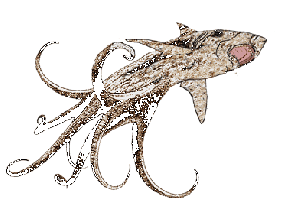The lusca is a name given to a sea monster reported from the Caribbean.
Description
The lusca has been described as either a multi-headed monster, a dragon-like creature, a cross between a giant shark and an octopus or a kind of evil spirit. The Lusca is said to grow over 75 feet (23 m) long, or even 200 feet (61 m) long. Other descriptions also mention that it can change colour, a characteristic commonly found in smaller octopuses.
Behavior
Luscas lurk in the Bahamian blue hole blue holes and attack ships or swimmers from below. The first sign of the attack is the whirlpool that forms under the ship. Then the lusca’s tentacles wrap around the ship and with a jerk it pulled into the depths of the ocean. Few people survived an attack by the lusca.
Sightings
Many reports of the creature are from the blue holes, off Andros, an island in the Bahamas. The St. Augustine Monster (an example of a globster), which washed up in 1896 on the Florida coast, is considered one of the better candidates for a possible lusca specimen. These claims, however, are doubtful; recent evidence suggests the St. Augustine Monster, like many globsters, was simply a large mass of decomposing adipose tissue from a Sperm Whale.
Theories
It has been suggested by cryptozoologists that the lusca is a gigantic octopus, far larger than the known giant octopuses of the genus Enteroctopus. However most scientists dismiss this theory, as there are no proven cases of other octopus species growing to half these lengths. To attack properly on the surface, the octopus would have to have one tentacle on the sea floor to balance itself; this would mean that such accounts, if real, would have to take place in relatively shallow water.

